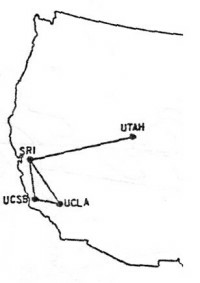2.1: Networking and Communication
- Page ID
- 90511
Introduction
In the early days of computing, computers were seen as devices for making calculations, storing data, and automating business processes. However, as the devices evolved, it became apparent that many of the functions of telecommunications could be integrated into the computer. During the 1980s, many organizations began combining their once-separate telecommunications and information systems departments into an Information Technology (IT) department. This ability for computers to communicate with one another and to facilitate communication between individuals and groups has had a major impact on the growth of computing over the past several decades.
Computer networking began in the 1960s with the birth of the Internet. However, while the Internet and web were evolving, corporate networking was also taking shape in the form of local area networks and client-server computing. The Internet went commercial in 1994 as technologies began to pervade all areas of the organization. Today it would be unthinkable to have a computer that did not include communications capabilities. This chapter reviews the different technologies that have been put in place to enable this communications revolution.
A Brief History of the Internet
In the Beginning: ARPANET
The story of the Internet, and networking in general, can be traced back to the late 1950s. The United States was in the depths of the Cold War with the USSR as each nation closely watched the other to determine which would gain a military or intelligence advantage. In 1957, the Soviets surprised the U.S. with the launch of Sputnik, propelling us into the space age. In response to Sputnik, the U.S. Government created the Advanced Research Projects Agency (ARPA), whose initial role was to ensure that the U.S. was not surprised again. It was from ARPA, now called DARPA ((Defense Advanced Research Projects Agency), that the Internet first sprang.
ARPA was the center of computing research in the 1960s, but there was just one problem. Many of the computers could not communicate with each other. In 1968 ARPA sent out a request for proposals for a communication technology that would allow different computers located around the country to be integrated together into one network. Twelve companies responded to the request, and a company named Bolt, Beranek, and Newman (BBN) won the contract. They immediately began work and were able to complete the job just one year later.
ARPA Net 1969
Professor Len Kleinrock of UCLA along with a group of graduate students were the first to successfully send a transmission over the ARPANET. The event occurred on October 29, 1969 when they attempted to send the word “login” from their computer at UCLA to the Stanford Research Institute. You can read their actual notes. The first four nodes were at UCLA, University of California, Stanford, and the University of Utah.
The Internet and the World Wide Web
Over the next decade, the ARPANET grew and gained popularity. During this time, other networks also came into existence. Different organizations were connected to different networks. This led to a problem. The networks could not communicate with each other. Each network used its own proprietary language, or protocol (see sidebar for the definition of protocol) to send information back and forth. This problem was solved by the invention of Transmission Control Protocol/Internet Protocol (TCP/IP). TCP/IP was designed to allow networks running on different protocols to have an intermediary protocol that would allow them to communicate. So as long as your network supported TCP/IP, you could communicate with all of the other networks running TCP/IP. TCP/IP quickly became the standard protocol and allowed networks to communicate with each other. It is from this breakthrough that we first got the term Internet, which simply means “an interconnected network of networks.”
- Wolcott, M. (2017). What is Web 2.0? MoneyWatch. Retrieved from https://www.cbsnews.com/news/what-is-web-20/↵
- Molla, R. (2017). These are the fastest and slowest Internet speeds”. Recode. Retrieved from https://www.recode.net/2017/6/9/1576...nternet-speeds↵
- International Telecommunications Union. (2018, January 23). UN Broadband Commission sets goal broadband targets to bring online the world’s 3.8 billion not connected to the Internet. Retrieved from https://www.itu.int/en/mediacentre/P...2018-PR01.aspx↵
- “Dean, J. (2014). 4G vs 5G Mobile Technology. Raconteur Retrieved from https://www.raconteur.net/technology...ile-technology.



